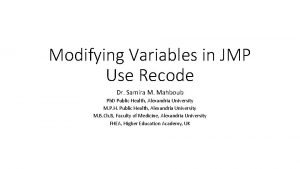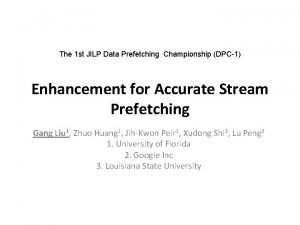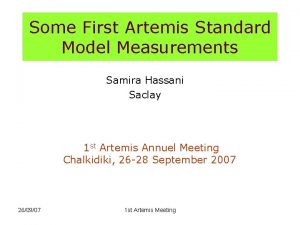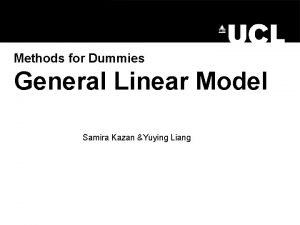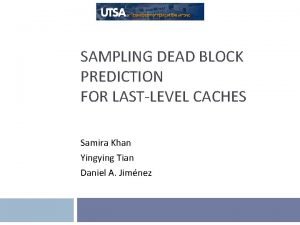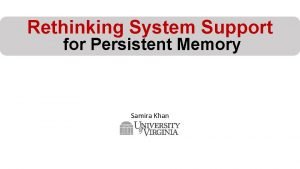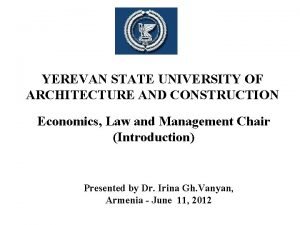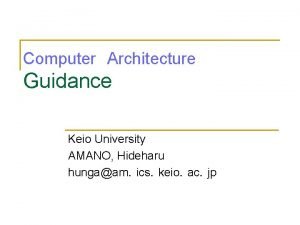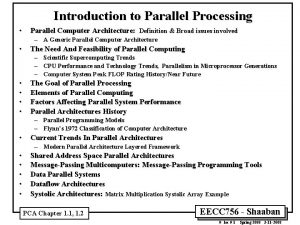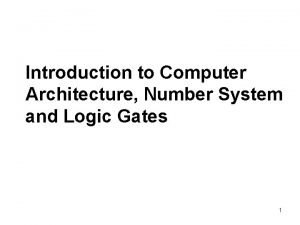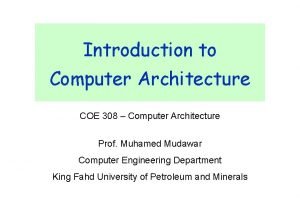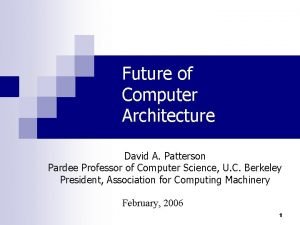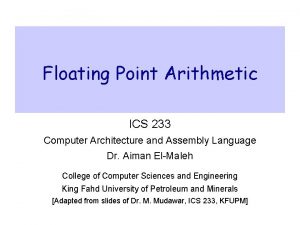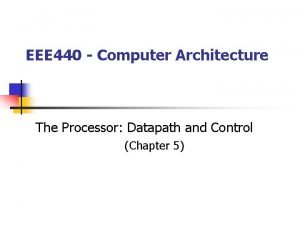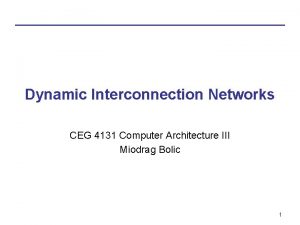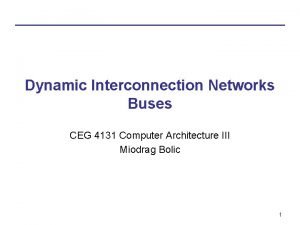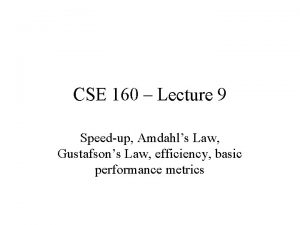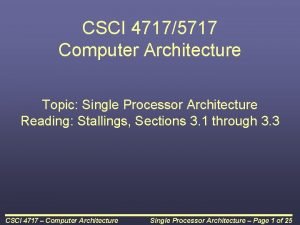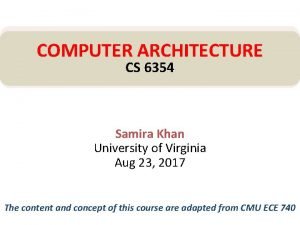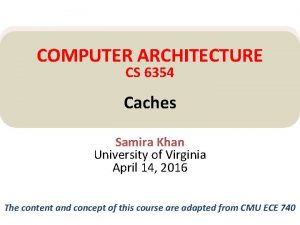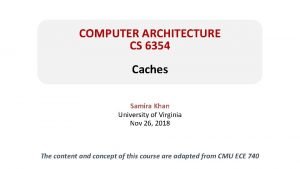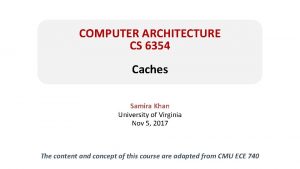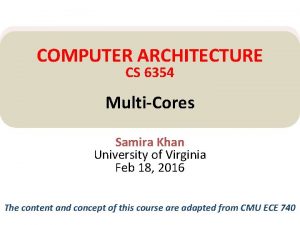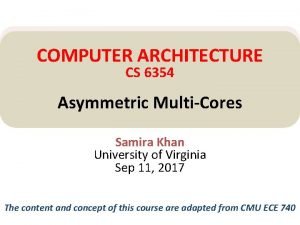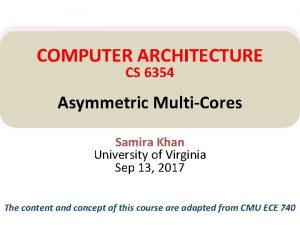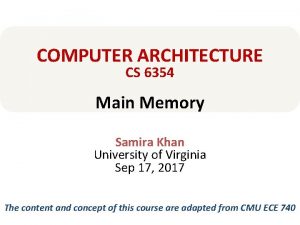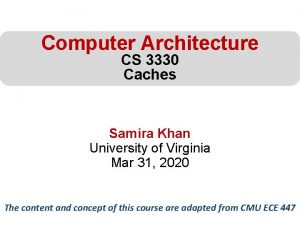COMPUTER ARCHITECTURE CS 6354 Prefetching Samira Khan University

























![Memory Latency Tolerance Techniques • Caching [initially by Wilkes, 1965] – Widely used, simple, Memory Latency Tolerance Techniques • Caching [initially by Wilkes, 1965] – Widely used, simple,](https://slidetodoc.com/presentation_image_h/c6e553c6cf69561e0bd9c90263e8e03f/image-26.jpg)















![Software Prefetching (II) for (i=0; i<N; i++) { __prefetch(a[i+8]); __prefetch(b[i+8]); sum += a[i]*b[i]; } Software Prefetching (II) for (i=0; i<N; i++) { __prefetch(a[i+8]); __prefetch(b[i+8]); sum += a[i]*b[i]; }](https://slidetodoc.com/presentation_image_h/c6e553c6cf69561e0bd9c90263e8e03f/image-42.jpg)


















- Slides: 60

COMPUTER ARCHITECTURE CS 6354 Prefetching Samira Khan University of Virginia April 26, 2016 The content and concept of this course are adapted from CMU ECE 740

AGENDA • Logistics • Review from last lecture • Prefetching 2

LOGISTICS • Final Presentation – April 28 and May 3 • Final Exam – May 6, 9. 00 am • Final Report Due – May 7 – Format: same as a regular paper (12 pages or less) – Introduction, Background, Related Work, Key Idea, Key Mechanism, Results, Conclusion 3

SHARED CACHES BETWEEN CORES • Advantages: – High effective capacity – Dynamic partitioning of available cache space • No fragmentation due to static partitioning – Easier to maintain coherence (a cache block is in a single location) – Shared data and locks do not ping pong between caches • Disadvantages – Slower access – Cores incur conflict misses due to other cores’ accesses • Misses due to inter-core interference • Some cores can destroy the hit rate of other cores – Guaranteeing a minimum level of service (or fairness) to each core is harder (how much space, how much bandwidth? ) 4

Fair Shared Cache Partitioning • Goal: Equalize the slowdowns of multiple threads sharing the cache • Idea: Dynamically estimate slowdowns due to sharing and assign cache blocks to balance slowdowns • Approximate slowdown with change in miss rate + Simple - Not accurate. Why? – Kim et al. , “Fair Cache Sharing and Partitioning in a Chip Multiprocessor Architecture, ” PACT 2004. 5

Problem with Shared Caches Processor Core 1 ←t 1 Processor Core 2 L 1 $ L 2 $ …… 6

Problem with Shared Caches t 2→ Processor Core 1 L 1 $ Processor Core 2 L 1 $ L 2 $ …… 7

Problem with Shared Caches Processor Core 1 ←t 1 t 2→ L 1 $ Processor Core 2 L 1 $ L 2 $ …… t 2’s throughput is significantly reduced due to unfair cache sharing. 8

Problem with Shared Caches 9

Fairness Metrics • Uniform slowdown • Minimize: – Ideally: 10

Block-Granularity Partitioning • Modified LRU cache replacement policy – G. Suh, et. al. , HPCA 2002 Current Partition P 2 Miss Target Partition P 1: 448 B P 1: 384 B P 2: 576 B P 2: 640 B LRU LRU 11

Block-Granularity Partitioning • Modified LRU cache replacement policy – G. Suh, et. al. , HPCA 2002 Current Partition Target Partition P 1: 448 B P 1: 384 B P 2: 576 B P 2: 640 B LRU P 2 Miss LRU * Current Partition LRU Target Partition P 1: 384 B P 2: 640 B LRU * LRU LRU 12

Dynamic Fair Caching Algorithm Miss. Rate alone P 1: Ex) Optimizing M 3 metric P 2: Miss. Rate shared P 1: P 2: Target Partition Repartitioning interval P 1: P 2: 13

Dynamic Fair Caching Algorithm Miss. Rate alone 1 st Interval P 1: 20% P 2: 5% Miss. Rate shared P 1: 20% P 2: 15% Target Partition Repartitioning interval P 1: 256 KB P 2: 256 KB 14

Dynamic Fair Caching Algorithm Miss. Rate alone Repartition! P 1: 20% P 2: 5% Miss. Rate shared Evaluate M 3 P 1: 20% / 20% P 2: 15% / 5% P 2: 15% Target Partition P 1: 256 KB P 1: 192 KB P 2: 256 KB P 2: 320 KB Repartitioning interval Partition granularity: 64 KB 15

Dynamic Fair Caching Algorithm Miss. Rate alone 2 nd Interval P 1: 20% P 2: 5% Miss. Rate shared P 1: 20% P 2: 15% P 2: 10% Target Partition Repartitioning interval P 1: 192 KB P 2: 320 KB 16

Dynamic Fair Caching Algorithm Miss. Rate alone Repartition! P 1: 20% P 2: 5% Miss. Rate shared P 1: 20% P 2: 15% P 2: 10% Target Partition Evaluate M 3 P 1: 20% / 20% P 2: 10% / 5% Repartitioning interval P 1: 192 KB P 1: 128 KB P 2: 320 KB P 2: 384 KB 17

Dynamic Fair Caching Algorithm Miss. Rate alone 3 rd Interval P 1: 20% P 2: 5% Miss. Rate shared P 1: 20% P 1: 25% P 2: 10% P 2: 9% Target Partition Repartitioning interval P 1: 128 KB P 2: 384 KB 18

Dynamic Fair Caching Algorithm Miss. Rate alone Repartition! P 1: 20% P 2: 5% Miss. Rate shared Do Rollback if: P 2: Δ<Trollback Δ=MRold-MRnew Miss. Rate shared P 1: 20% P 1: 25% P 2: 10% P 2: 9% Target Partition Repartitioning interval P 1: 128 KB P 1: 192 KB P 2: 384 KB P 2: 320 KB 19

Dynamic Fair Caching Results • Improves both fairness and throughput 20

Effect of Partitioning Interval • Fine-grained partitioning is important for both fairness and throughput 21

Benefits of Fair Caching • Problems of unfair cache sharing – Sub-optimal throughput – Thread starvation – Priority inversion – Thread-mix dependent performance • Benefits of fair caching – Better fairness – Better throughput – Fair caching likely simplifies OS scheduler design 22

Advantages/Disadvantages of the Approach • Advantages + No (reduced) starvation + Better average throughput • Disadvantages - Scalable to many cores? - Is this the best (or a good) fairness metric? - Does this provide performance isolation in cache? - Alone miss rate estimation can be incorrect (estimation interval different from enforcement interval) 23

Memory Latency Tolerance 24

Cache Misses Responsible for Many Stalls L 2 Misses 512 KB L 2 cache, 500 -cycle DRAM latency, aggressive stream-based prefetcher Data averaged over 147 memory-intensive benchmarks on a high-end x 86 processor model 25
![Memory Latency Tolerance Techniques Caching initially by Wilkes 1965 Widely used simple Memory Latency Tolerance Techniques • Caching [initially by Wilkes, 1965] – Widely used, simple,](https://slidetodoc.com/presentation_image_h/c6e553c6cf69561e0bd9c90263e8e03f/image-26.jpg)
Memory Latency Tolerance Techniques • Caching [initially by Wilkes, 1965] – Widely used, simple, effective, but inefficient, passive – Not all applications/phases exhibit temporal or spatial locality • Prefetching [initially in IBM 360/91, 1967] – Works well for regular memory access patterns – Prefetching irregular access patterns is difficult, inaccurate, and hardwareintensive • Multithreading [initially in CDC 6600, 1964] – Works well if there are multiple threads – Improving single thread performance using multithreading hardware is an ongoing research effort • Out-of-order execution [initially by Tomasulo, 1967] – Tolerates irregular cache misses that cannot be prefetched – Requires extensive hardware resources for tolerating long latencies – Runahead execution alleviates this problem (as we will see today) 26

Prefetching

Outline of Prefetching Lecture • Why prefetch? Why could/does it work? • The four questions – What (to prefetch), when, where, how • • Software prefetching Hardware prefetching algorithms Execution-based prefetching Prefetching performance – Coverage, accuracy, timeliness – Bandwidth consumption, cache pollution 28

Prefetching • Idea: Fetch the data before it is needed (i. e. pre-fetch) by the program • Why? – Memory latency is high. If we can prefetch accurately and early enough we can reduce/eliminate that latency. – Can eliminate compulsory cache misses – Can it eliminate all cache misses? Capacity, conflict? • Involves predicting which address will be needed in the future – Works if programs have predictable miss address patterns 29

Prefetching and Correctness • Does a misprediction in prefetching affect correctness? • No, prefetched data at a “mispredicted” address is simply not used • There is no need for state recovery – In contrast to branch misprediction or value misprediction 30

Basics • In modern systems, prefetching is usually done in cache block granularity • Prefetching is a technique that can reduce both – Miss rate – Miss latency • Prefetching can be done by – hardware – compiler – programmer 31

How a HW Prefetcher Fits in the Memory System 32

Prefetching: The Four Questions • What – What addresses to prefetch • When – When to initiate a prefetch request • Where – Where to place the prefetched data • How – Software, hardware, execution-based, cooperative 33

Challenges in Prefetching: What • What addresses to prefetch – Prefetching useless data wastes resources • • Memory bandwidth Cache or prefetch buffer space Energy consumption These could all be utilized by demand requests or more accurate prefetch requests – Accurate prediction of addresses to prefetch is important • Prefetch accuracy = used prefetches / sent prefetches • How do we know what to prefetch – Predict based on past access patterns – Use the compiler’s knowledge of data structures • Prefetching algorithm determines what to prefetch 34

Challenges in Prefetching: When • When to initiate a prefetch request – Prefetching too early • Prefetched data might not be used before it is evicted from storage – Prefetching too late • Might not hide the whole memory latency • When a data item is prefetched affects the timeliness of the prefetcher • Prefetcher can be made more timely by – Making it more aggressive: try to stay far ahead of the processor’s access stream (hardware) – Moving the prefetch instructions earlier in the code (software) 35

Challenges in Prefetching: Where (I) • Where to place the prefetched data – In cache + Simple design, no need for separate buffers -- Can evict useful demand data cache pollution – In a separate prefetch buffer + Demand data protected from prefetches no cache pollution -- More complex memory system design - Where to place the prefetch buffer - When to access the prefetch buffer (parallel vs. serial with cache) - When to move the data from the prefetch buffer to cache - How to size the prefetch buffer - Keeping the prefetch buffer coherent • Many modern systems place prefetched data into the cache – Intel Pentium 4, Core 2’s, AMD systems, IBM POWER 4, 5, 6, … 36

Challenges in Prefetching: Where (II) • Which level of cache to prefetch into? – Memory to L 2, memory to L 1. Advantages/disadvantages? – L 2 to L 1? (a separate prefetcher between levels) • Where to place the prefetched data in the cache? – Do we treat prefetched blocks the same as demand-fetched blocks? – Prefetched blocks are not known to be needed • With LRU, a demand block is placed into the MRU position • Do we skew the replacement policy such that it favors the demand-fetched blocks? – E. g. , place all prefetches into the LRU position in a way? 37

Challenges in Prefetching: Where (III) • Where to place the hardware prefetcher in the memory hierarchy? – In other words, what access patterns does the prefetcher see? – L 1 hits and misses – L 1 misses only – L 2 misses only • Seeing a more complete access pattern: + Potentially better accuracy and coverage in prefetching -- Prefetcher needs to examine more requests (bandwidth intensive, more ports into the prefetcher? ) 38

Challenges in Prefetching: How • Software prefetching – ISA provides prefetch instructions – Programmer or compiler inserts prefetch instructions (effort) – Usually works well only for “regular access patterns” • Hardware prefetching – Hardware monitors processor accesses – Memorizes or finds patterns/strides – Generates prefetch addresses automatically • Execution-based prefetchers – A “thread” is executed to prefetch data for the main program – Can be generated by either software/programmer or hardware 39

Software Prefetching (I) • Idea: Compiler/programmer places prefetch instructions into appropriate places in code n Mowry et al. , “Design and Evaluation of a Compiler Algorithm for Prefetching, ” ASPLOS 1992. • Prefetch instructions prefetch data into caches • Compiler or programmer can insert such instructions into the program 40

X 86 PREFETCH Instruction microarchitecture dependent specification different instructions for different cache levels 41
![Software Prefetching II for i0 iN i prefetchai8 prefetchbi8 sum aibi Software Prefetching (II) for (i=0; i<N; i++) { __prefetch(a[i+8]); __prefetch(b[i+8]); sum += a[i]*b[i]; }](https://slidetodoc.com/presentation_image_h/c6e553c6cf69561e0bd9c90263e8e03f/image-42.jpg)
Software Prefetching (II) for (i=0; i<N; i++) { __prefetch(a[i+8]); __prefetch(b[i+8]); sum += a[i]*b[i]; } while (p) { __prefetch(p next); __prefetch(p next); work(p data); p = p next; } } Which one is better? • Can work for very regular array-based access patterns. Issues: -- Prefetch instructions take up processing/execution bandwidth – How early to prefetch? Determining this is difficult -- Prefetch distance depends on hardware implementation (memory latency, cache size, time between loop iterations) portability? -- Going too far back in code reduces accuracy (branches in between) – Need “special” prefetch instructions in ISA? • Alpha load into register 31 treated as prefetch (r 31==0) • Power. PC dcbt (data cache block touch) instruction -- Not easy to do for pointer-based data structures 42

Software Prefetching (III) • Where should a compiler insert prefetches? – Prefetch for every load access? • Too bandwidth intensive (both memory and execution bandwidth) – Profile the code and determine loads that are likely to miss • What if profile input set is not representative? – How far ahead before the miss should the prefetch be inserted? • Profile and determine probability of use for various prefetch distances from the miss – What if profile input set is not representative? – Usually need to insert a prefetch far in advance to cover 100 s of cycles of main memory latency reduced accuracy 43

Hardware Prefetching (I) • Idea: Specialized hardware observes load/store access patterns and prefetches data based on past access behavior • Tradeoffs: + Can be tuned to system implementation + Does not waste instruction execution bandwidth -- More hardware complexity to detect patterns - Software can be more efficient in some cases 44

Next-Line Prefetchers • Simplest form of hardware prefetching: always prefetch next N cache lines after a demand access (or a demand miss) – Next-line prefetcher (or next sequential prefetcher) – Tradeoffs: + Simple to implement. No need for sophisticated pattern detection + Works well for sequential/streaming access patterns (instructions? ) -- Can waste bandwidth with irregular patterns -- And, even regular patterns: - What is the prefetch accuracy if access stride = 2 and N = 1? - What if the program is traversing memory from higher to lower addresses? - Also prefetch “previous” N cache lines? 45

Stride Prefetchers • Two kinds – Instruction program counter (PC) based – Cache block address based • Instruction based: – Baer and Chen, “An effective on-chip preloading scheme to reduce data access penalty, ” SC 1991. – Idea: • Record the distance between the memory addresses referenced by a load instruction (i. e. stride of the load) as well as the last address referenced by the load • Next time the same load instruction is fetched, prefetch last address + stride 46

Instruction Based Stride Prefetching Load Inst PC • Load Inst. Last Address Last PC (tag) Referenced Stride ……. …… Confiden ce What is the problem with this? – How far can the prefetcher get ahead of the demand access stream? – Initiating the prefetch when the load is fetched the next time can be too late • Load will access the data cache soon after it is fetched! – Solutions: • Use lookahead PC to index the prefetcher table (decouple frontend of the processor from backend) • Prefetch ahead (last address + N*stride) • Generate multiple prefetches 47

Cache-Block Address Based Stride Prefetching Block address Address tag Stride ……. …… Control/Confiden ce • Can detect – A, A+N, A+2 N, A+3 N, … – Stream buffers are a special case of cache block address based stride prefetching where N = 1 48

FIFO sequentially prefetched cache lines • On a load miss check the head of all stream buffers for an address match – if hit, pop the entry from FIFO, update the cache with data – if not, allocate a new stream buffer to the new miss address (may have to recycle a stream buffer following LRU policy) FIFO DCache • Stream buffer FIFOs are continuously toppedoff with subsequent cache lines whenever there is room and the bus is not busy FIFO Memory interface • Stream Buffers (Jouppi, ISCA 1990) Each stream buffer holds one stream of FIFO Jouppi, “Improving Direct-Mapped Cache Performance by the Addition of a Small Fully-Associative Cache and Prefetch Buffers, ” ISCA 1990. 49

Stream Buffer Design 50

Stream Buffer Design 51

• These slides were not covered in the class • They are for your benefit 52

Prefetcher Performance (I) • Accuracy (used prefetches / sent prefetches) • Coverage (prefetched misses / all misses) • Timeliness (on-time prefetches / used prefetches) • Bandwidth consumption – Memory bandwidth consumed with prefetcher / without prefetcher – Good news: Can utilize idle bus bandwidth (if available) • Cache pollution – Extra demand misses due to prefetch placement in cache – More difficult to quantify but affects performance 53

Prefetcher Performance (II) • Prefetcher aggressiveness affects all performance metrics • Aggressiveness dependent on prefetcher type • For most hardware prefetchers: – Prefetch distance: how far ahead of the demand stream – Prefetch degree: how many prefetches per demand access Access Stream XX+1 Prefetch Degree Predicted Stream 123 Pmax P Pmax Very Conservative Middle of Prefetch the Very Road Distance Aggressive Pmax 54

Prefetcher Performance (III) • How do these metrics interact? • Very Aggressive Prefetcher (large prefetch distance & degree) – Well ahead of the load access stream – Hides memory access latency better – More speculative + Higher coverage, better timeliness -- Likely lower accuracy, higher bandwidth and pollution • Very Conservative Prefetcher (small prefetch distance & degree) – Closer to the load access stream – Might not hide memory access latency completely – Reduces potential for cache pollution and bandwidth contention + Likely higher accuracy, lower bandwidth, less polluting -- Likely lower coverage and less timely 55

Prefetcher Performance (IV) 56

Prefetcher Performance (V) 48% 29% n Srinath et al. , “Feedback Directed Prefetching: Improving the Performance and Bandwidth-Efficiency of Hardware Prefetchers“, HPCA 2007. 57

Feedback-Directed Prefetcher Throttling (I) • Idea: – Dynamically monitor prefetcher performance metrics – Throttle the prefetcher aggressiveness up/down based on past performance – Change the location prefetches are inserted in cache based on past performance High Accuracy Not-Late Polluting Increase Decrease Med Accuracy Low Accuracy Not-Polluting Not-Poll Late Decrease Not-Late Increase Decrease No Change 58

Feedback-Directed Prefetcher Throttling (II) 11% 13% n n Srinath et al. , “Feedback Directed Prefetching: Improving the Performance and Bandwidth-Efficiency of Hardware Prefetchers“, HPCA 2007. 59

COMPUTER ARCHITECTURE CS 6354 Prefetching Samira Khan University of Virginia Apr 26, 2016 The content and concept of this course are adapted from CMU ECE 740
 Computer architecture
Computer architecture Samira khan uva
Samira khan uva Jmp recode
Jmp recode Prefeching
Prefeching Prefetching relevant priors
Prefetching relevant priors Samira hassani
Samira hassani Samira zegrari
Samira zegrari Samira kazan
Samira kazan Fatemeh soltani
Fatemeh soltani Samira kazan origin
Samira kazan origin Samira block
Samira block How to counter samira
How to counter samira Bus design in computer architecture
Bus design in computer architecture Difference computer organization and architecture
Difference computer organization and architecture Basic computer organization
Basic computer organization Architecture business cycle
Architecture business cycle Call and return architecture
Call and return architecture Fundamental and incidental interactions
Fundamental and incidental interactions Slot modular architecture
Slot modular architecture Yerevan state university of architecture and construction
Yerevan state university of architecture and construction Keio university architecture
Keio university architecture 詹景裕
詹景裕 Computer organization and architecture 10th solution
Computer organization and architecture 10th solution Ocs architecture
Ocs architecture Virtual lab computer organization
Virtual lab computer organization Introduction to computer organization and architecture
Introduction to computer organization and architecture Timing and control in computer architecture
Timing and control in computer architecture Computer architecture: concepts and evolution
Computer architecture: concepts and evolution Programmed i/o in computer architecture
Programmed i/o in computer architecture Floating point division algorithm in computer architecture
Floating point division algorithm in computer architecture Immediate addressing mode
Immediate addressing mode Chordal ring
Chordal ring Smt computer architecture
Smt computer architecture Li in mips
Li in mips Collision vector in pipelining
Collision vector in pipelining Instruction format in computer architecture
Instruction format in computer architecture What is nano programming in computer architecture
What is nano programming in computer architecture Microprogram sequencer block diagram
Microprogram sequencer block diagram Memory system
Memory system Tlb computer architecture
Tlb computer architecture Linear vs nonlinear pipelining
Linear vs nonlinear pipelining Computer architecture definition
Computer architecture definition Parallel processing definition
Parallel processing definition Number system in computer architecture
Number system in computer architecture Computer architecture definition
Computer architecture definition Examples of isa
Examples of isa Definition of input and output devices
Definition of input and output devices Branch prediction
Branch prediction David patterson computer architecture
David patterson computer architecture Example of sisd
Example of sisd What is guard bit in computer architecture
What is guard bit in computer architecture Sequential interrupt processing
Sequential interrupt processing Datapath in computer architecture
Datapath in computer architecture Explain virtual memory in computer architecture
Explain virtual memory in computer architecture Computer architecture definition
Computer architecture definition Dynamic interconnection network in computer architecture
Dynamic interconnection network in computer architecture Computer buses
Computer buses Harris & harris digital design and computer architecture
Harris & harris digital design and computer architecture Computer architecture
Computer architecture Gustafson's law
Gustafson's law Instruction cycle in computer architecture
Instruction cycle in computer architecture


